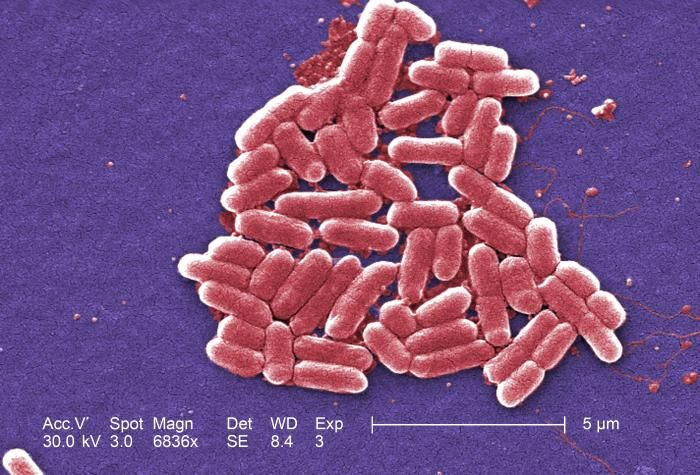
PROKARYOTES
Proteobacteria
[Public Domain]
Chapter Outline
- Description of Prokaryotes
- Classification of Prokaryotes
- Bacteria
- Cyanobacteria
- Proteobacteria
- Gram Positive Bacteria
- Archaea

Links to external sites will appear in pop-up windows.
Making A Bioluminescent Lantern
PURPLE BACTERIA AND RELATIVES
The phylum Proteobacteria contains about a third of all bacteria. All members of the phylum are Gram-negative, but there is great diversity beyond that. Many known bacterial diseases are caused by Proteobacteria but there are also members of the phylum that play important roles in the nitrogen, sulfur and other chemical cycles. The Proteobacteria are divided into five classes, simply named after the first five letters of the Greek alphabet: Alpha, Beta, Gamma, Delta and Epsilon.
Readings:
|
| ALPHAPROTEOBACTERIA | |
The Alphaproteobacteria include the bacteria most closely related to mitochondria. The purple non-sulfur bacteria in this group, which engage in a type of anoxygenic photosynthesis, share a relatively close ancestor with that organelle which supplies the bulk of energy to eukaryotes. Some Alpha members are important nitrogen-fixers (Rhizobium, Bradyrhizobium and Azospirrilum). These organisms live in the roots of certain plants and convert molecular nitrogen into ammonia. The group also includes nitrifiers, such as Nitrobacter, which convert nitrite into nitrate. There are even species with structures called magnetosomes which cause the organisms to align with earth's magnetic field. Pathogens in the Alpha Subdivision include Agrobacterium, which forms "galls" in plants, Brucella, which causes brucellosis in animals, Ehrlichia, a tick-borne disease which causes ehrlichiosis, and Rickettsia, another tick-borne disease which causes Rocky Mountain Spotted Fever.
Resources:
|
| BETAPROTEOBACTERIA | |
The Betaproteobacteria are dominated by heterotrophs and includes some important oxidizers. The organism Nitrosomonas is a nitrifying Beta member that converts ammonium into nitrite which is then used by Nitrobacter to form the nitrate that can be absorbed by plants. The polar ice psychrophile (cold-lover) Polaromonas, which can live in below-freezing temperatures, is in the Beta Subdivision. Beta pathogens include Neisseria meningitidis, which can cause meningitis and Neisseria gonorrheae, which causes gonorrhea. As of this writing, gonorrhea can only be treated by a single class of antibiotics in places like Hawaii, Colorado, Washington and California because strains there have become resistant. If they become resistant to the remaining class of antibiotics, those strains will inevitably spread to other states and countries and more women will potentially become sterile.
Resources:
|
| GAMMAPROTEOBACTERIA | |
The Gammaproteobacteria include the purple sulfur bacteria, such as Chromatium, and the Enterobacteria, such as Escherichia coli (E. coli) and Salmonella. The term "enterobacteria" refers to the fact that these organisms live in the guts of animals. Enterobacteria like E. coli have strains which can be harmful but there are "normal" strains which are important for supplying vitamins to their human hosts. The group includes some bioluminescent (glowing) bacteria, such as Photobacterium and Vibrio. These sometime live in the light-producing organs of deep sea fish and are the actual source of the light from the organ. The bacteria must be supplied with oxygen to glow, and the fish can control the flow of oxygen into the organ, thus controlling when the organ glows and when it doesn't. Denitrifiers, such as Pseudomonas in the Gamma Subdivision play a role in the nitrogen cycle by converting nitrate into gaseous compounds such as nitric oxide, nitrous oxide or molecular nitrogen. There are also a variety of pathogens in the Gamma group which cause some well known diseases such as cholera, meningitis, typhois fever and the plague.
Resources:
|
| DELTAPROTEOBACTERIA | |
The Deltaproteobacteria include a group called Myxobacteria which have complex life cycles that include a fruiting stage similar to that of some fungi. There is also a group of Deltas that play roles in the sulfur cycle by reducing sulfate and sulfur. They require anaerobic environments and typically live with green sulfur bacteria which oxidize H2S back to S for the Deltas to use. An interesting Delta member is Bdellovibrio which is an intracellular parasite of other bacteria. They make a hole in the cell wall of the host and live on the substances in the periplasm.
Resources:
|
| EPSILONPROTEOBACTERIA | |
The Epsilon Subdivision is a small group with many species that are resistant to antibiotics. They tend to be intestinal organisms and some cause disease. Helicobacter pylori is the bacterium which causes peptic ulcers.
Resources:
|
| [ Previous Page ] | [ Next Page ] |